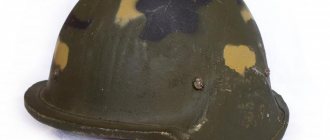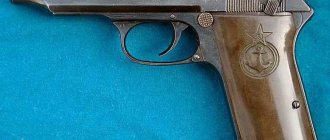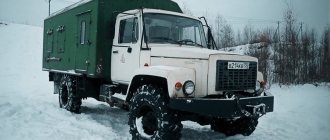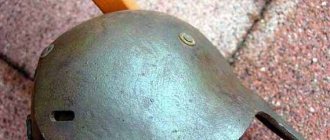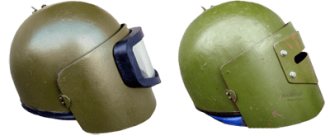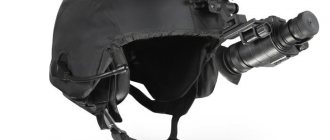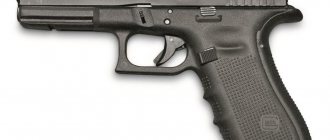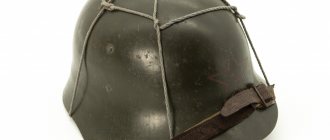The time for soldiers to use feathered hats, shakos and caps with visors is long gone. But the various protective helmets that battle armor has transformed into are coming back from the past. Despite the fact that the pedigree of the helmet dates back to ancient times, thanks to developing technologies it has been possible to create a wide variety of new models that can provide the maximum level of protection. One of the most effective means of protection was the Altyn helmet.
Steel helmets
Until the twentieth century, steel was used to make helmets. Such means could only provide protection against stones and small fragments flying at low speed. Steel helmets were effective in cases where a striking element weighing no more than one kilogram hit the head. If the speed of the fragment exceeded 650 m/s, it already posed a serious danger to the fighter. According to statistics, during the Great Patriotic War these destructive weapons were the most common.
Need for better protection
In the late 50s, due to the intensive development of armaments in armies around the world, the Soviet military leadership was more acutely faced with the need to improve the protection of military personnel and law enforcement officers than ever before. The army and law enforcement agencies were required to be provided with modernized helmets that meet international standards. The Altyn helmet, which began to be developed at the Steel Research Institute in 1980, became such a means of protection. The Swiss Tig, which has been used by anti-terrorism special forces in Europe for two years, was used as the basis for the future helmet.
On December 27, 1979, Tig was tested by Alpha fighters of the USSR KGB in Afghanistan during the storming of Amin's palace. The quality of the Swiss helmet was appreciated by the leadership of the Soviet state security, and limited quantities of Tig were purchased purely for the needs of the KGB. It was on the model of this product that the Altyn helmet was designed.
The same, but with mother-of-pearl buttons
Some sources claim that the deal was carried out through third countries, others that PSH-77 was purchased directly from the Swiss - the details of this trade agreement are still shrouded in darkness, including the timing and size of deliveries. Perhaps only the first “baptism of fire” of helmets is known for certain: they were used by some fighters of the Thunder group during Operation Storm 333 to capture Amin’s palace in Kabul.
Soviet special forces soldiers in Afghanistan. Helmets - PSH-77
On the same topic
Take care of your head: from a medieval helmet to a modern helmet
Based on the experience of the first operation, it turned out that the “pot” is a good thing, but does not fully meet domestic needs. German medical requirements strictly limited the weight of the helmet - this reduced its protective properties. The radio versions of the PSH-77, of course, were not suitable for our communications: the wrong speakers, microphones, connectors - but it was necessary to ensure their compatibility. And the external fittings themselves were poorly protected; they could easily be damaged by a bullet or shrapnel.
As a result, the products coming from Switzerland were sent to Balashikha near Moscow, where at the plant of one of the departmental “KGB” research institutes, local craftsmen adapted them to Soviet realities: they were completely disassembled, replaced with domestic ones and repainted using Swiss technology. It was then, in the first half of the 80s, that the name “Altyn” arose - as a designation for a project to adapt PSH-77 to domestic requirements.
Again Afghanistan, again PSH-77
On the same topic
Top 5 special forces equipment items
The domestic industry managed to master the stamping of titanium sheets by 1986 - this was a joint development of the Steel Research Institute and the National Institute of Aviation Technologies (NIAT), and the design documentation for the 6B6S / Altyn-R1 helmet was completed only in 1991. Our product was slightly larger than the Swiss one and surpassed it in protective properties by 10-15 percent.
Test shootings showed that the first “Altyns” confidently held only a 9x18 mm bullet fired from five meters from a Makarov pistol, but shelling from a TT was not encouraging: 7.62x25 mm easily pierced the cap. In addition, “times have become difficult,” so production was very uneven: it was possible to supply consumers with no more than 120 sets of helmets per year.
By the end of the 90s, production of the modernized version of “Altyn-R2” began: the thickness of the titanium cap in it was increased to four millimeters. Even a “tetesh” bullet could not cope with such a helmet. In total, the production of this Soviet “special forces” accessory continued until 2009 (the last batch went to Cuban special forces). However, they can still be found in regional Russian divisions of the Ministry of Internal Affairs.
The helmets that replaced the Altyn may be lighter, more modern, more comfortable, but it seems they still have not managed to surpass the latest version in terms of armor protection.
Start of creating a new helmet
In 1980, the leadership of the special forces of the State Security Committee of the Soviet Union handed over a model of the Tig helmet to the specialists of the Steel Research Institute. The workers were instructed to use this Swiss model to create their own domestic helmet, which in its technical indicators should not be inferior to the foreign model. Additionally, as source material, the KGB officers provided the engineers with all the necessary information on the manufacture of titanium helmets, collected at one time by the Austrian company Ulbrichts.
“Altyn”: why special forces don’t like the legendary helmet
The appearance of Soviet and Russian special forces is often compared to the appearance of divers or cosmonauts. But few people know that the recognizable Altyn helmet, popularized in many computer games, is an effective, but far from the most convenient means of protection.
Not made in Switzerland
In the early 1980s, the external and internal situation of the USSR became sharply complicated. Against the backdrop of the entry of Soviet troops into Afghanistan, the country's leadership feared that the Moscow Olympics could be overshadowed by a terrorist attack similar to the Munich events of 1972. At the same time, labor unrest began in Poland, a key country in the Soviet bloc. It is not surprising that it was in 1980 that the Research Institute of Steel received an order to develop a new helmet for special operations.
The Altyn helmet was created “in the image and likeness” of the Swiss armored helmet Tig PSH-77, a batch of which was purchased for the KGB of the USSR in the late 1970s. The Western novelty performed well in Kabul, when Soviet special forces stormed Amin’s palace. However, even Andropov’s department could not afford to spend scarce currency on the constant purchase of helmets. Therefore, domestic engineers were given the task of making a helmet of protection class 2 no worse than the Swiss one, only cheaper. Hence, perhaps the name - “altyn” in Rus' was the name for a 3-kopeck coin. To facilitate the work of the Steel Research Institute, the KGB “shared” with it the technology for manufacturing a titanium helmet from the Austrian company Ulbrichts, which had fallen into the hands of Soviet agents.
In general, the Soviet replica, which took 4 whole years to create, repeated the main features of the European originals and even, as the creators assured, was superior to Tig in strength. The safety of the skull bones was ensured by a titanium shell 3 mm thick and a suspension made of aramid fabric. And the face was protected by a folding visor with a polycarbonate visor. KGB specialists, having received the dome from the Research Institute of Steel, supplemented the design with a radio headset for negotiations of the task force. The Altyn helmet reliably protected the head from pistol bullets and shrapnel, which was especially important in urban conditions. The protective agent was used, for example, in the Alpha and Vympel divisions. The helmet performed well in both Chechen wars and in many modern FSB operations.
The Altyn helmet (and its copy, the K6-3 helmet) was larger in size compared to the Swiss prototype. Because of its size, the special forces nicknamed it “the pot.” Bulky and heavy, it reduced the maneuverability of a fighter - meanwhile, a delay of even a split second could be decisive during assault operations. Constantly wearing a helmet during training put a lot of strain on the neck muscles. In addition, pressure was felt on the top of the head. For medical reasons, you can wear it for no more than 3 hours at a time, but operations often last much longer, and during the process the fighters certainly do not have the opportunity to “rest and relax.”
What was improved by KGB specialists?
The helmet model provided by the designers of the research institute was a dome that had only a titanium shell. There was no aramid support in the design of the product. The titanium shell did not exceed 0.4 cm. State security specialists equipped the helmet with an aramid support and reduced the thickness of the titanium to 0.3 cm.
The domestic protective product, created according to the Swiss model, had a slightly different form, but in terms of quality it turned out to be no less reliable than Tig. The Soviet helmet differed from the foreign model in the type and location of the radio headset. Some Altyn models were never equipped with intercoms.
KGB officers created several versions of the helmet, which differed in the following parameters:
- location of protective boxes for buttons;
- connectors;
- type of undertie;
- the size of the armored glass of the visor for the visor.
Soviet specialists also created a version of the helmet with a fabric cover. Compared to the Swiss Tig, the Altyn helmet turned out to be larger.
Heavy helmet "Vulcan-5"
Undoubtedly, this is the most durable helmet in the game, with a score of 55 and impressive coverage of the back of the head, head and ears. It's armor class 6, the highest you can have, so it has some great points, such as its weight of 4.5kg for its cost. However, it has serious shortcomings. It doesn't have a full face shield, just a visor, and has high noise reduction, -7% movement speed, -20 ergonomics, and a painful -33% turning speed. If you want the best protection in the game, buy the Vulkan, but if you don't think the price of movement is worth it, check out any other great helmet.
Description
Impact-resistant fiberglass and titanium were used to manufacture the protective equipment.
- In early models of the helmet, the thickness of the titanium shell was 0.4 cm.
- In samples manufactured between 1984 and 1990, the titanium layer was reduced to 0.3 cm, and an aramid support and radio headset were added to the helmet design.
- "Altyn" consisted of a solid dome. There were no seams in the design of this product.
- The product was equipped with a rubber edging.
- The weight of the helmet varied from 3.5 to 4.0 kilograms.
- The model was equipped with a special visor made of polycarbonate glass.
- A case was provided for some versions.
- A unique suspension system was installed on the Altyn helmet, with the help of which it could be easily adjusted to the size of the head.
- Some versions were equipped with intercoms.
Modern
In this article we will look at modern armored helmets
, the history of their creation and the specifics of their use. Despite the fact that armored helmets were used both in the Middle Ages and during the world wars, the history of modern assault armored helmets can be dated back to the second half of the 20th century.
In the mid-70s of the 20th century, the “Tig” PSH-77
. The helmet was produced with an adjustable balaclava and a movable radio headset. Has 2 protection class. Total weight 4 kg, without visor 2.7 kg. Moreover, this armored helmet had 2 visor options: polycarbonate bulletproof and titanium with a wide slot in the middle, closed with polycarbonate. This helmet was widely used in European special forces, in particular it was supplied to the German GSG-9 from 1978 to 1999.
It is also necessary to say that in the second half of the 20th century, only two European companies produced titanium assault armored helmets. In Austria it is Ulbricht, and in Switzerland TIG. An interesting feature of the Austrian helmet Ulbrichts AM95
, is its shape and the presence of special grooves with active headphones.
Altyn was created based on the TIG.
.
The first helmets had a titanium thickness of 4 mm and did not have an aramid liner. In the early nineties, the helmet received an aramid liner, and the thickness of the helmet was reduced to 3 mm. The Altyn helmet was equipped with a radio headset, connected via a connecting cord to a wearable radio station placed either on the unloading vest or on the fighter’s belt. Altyn became the first Soviet helmet to have face protection using a visor made of titanium and bullet-resistant polymer glass. The armored helmet has protection class 2 and protects against bullets with a steel core from PSM 5.45 caliber pistols at speeds up to 335 m/s and from 7.62 caliber TT pistols at speeds up to 445 m/s. The weight of the helmet is from 3 and a half to 4 kg. Externally, the Altyn can be distinguished from the TIG helmet only by a different visor shape and a slightly larger dome with characteristic edges. This helmet was used by special forces for a long time
, as it had good characteristics and high reliability. Used during military conflicts in Afghanistan and Chechnya. Today Altyn is not produced.
In 1981, a special titanium helmet SSSH-81 was developed with the designation “Sphere”
, having a distinctive design. Thus, the dome of the helmet is formed by three separate titanium armor elements 3 mm thick, placed in the pockets of a special cover. The helmet does not have a visor. The helmet protected the head over the entire area, with the exception of the face area, according to the second class of protection, from bullets fired from PM, APS, TT and PSM pistols, as well as from any fragments. Soon the SSH-81 "Sphere" helmet was modernized and the SSSH-94 "SPHERE-S" helmet appeared. The letter “C” in the name meant that the armor elements in the helmet were made not of titanium, but of special armored steel. Externally, the helmets are absolutely indistinguishable. The advantage of steel armor was that it became less brittle than titanium armor elements STS-81, and the toughness of steel was higher than that of titanium. Despite the fact that the helmet is now out of production, it continues to be used in certain special units.
In the second half of the 80s of the 20th century, a new helmet was developed as an alternative replacement for the Sphere helmet, which did not have the ability to install an armored visor. And in 1991, based on the Altyn helmet, the Mask 1
. Unlike its predecessor, the body of Mask 1 is made not of titanium, but of monolithic armor steel. The protection class of the dome is 2, the visor with a polycarbonate insert is 1 protection class. The weight of the dome is 2.6 kg, the visor is 1 kg. The internal equipment of the helmet is designed to absorb the dynamic impact of bullets and shrapnel on the head during shelling. Production of the helmet has now been discontinued.
The armored helmet has modifications: Mask 1Sh – with a special steel slotted visor, which has protection class 2 and Mask 1P, additionally equipped with a radio headset.
In the mid-90s of the 20th century, the K6-3
. In fact, this helmet is a copy of Altyn. It is also made of 3mm thick titanium and has a liner made of aramid fabric. The front part is protected by a visor of class 1 protection made of titanium, which contains an insert made of polycarbonate or quartz glass in several layers. The helmet dome has class 2 armor protection and protects against pistol bullets and 1 gram fragments flying at speeds of up to 750 m/s. The helmet manufacturer, the Steel Research Institute, did not have the right to release Altyn for sale, and therefore its commercial copy, K6-3, was created. In addition, K6-3 differs from Altyn in the absence of a radio headset on the outside of the helmet. The weight of the helmet is from 3 and a half to 4 kg, depending on the configuration. This helmet is still in production today.
Also in the 90s of the last century, the ZSh-1
. Unlike other armored helmets, it is made of aramid fabric and has 1 protection class. The visor on the helmet is made of transparent polycarbonate and is shockproof. The low level of protection of the helmet is offset by its weight, which is only one and a half kilograms, which is two times lighter than a standard armored helmet. This helmet was created primarily for the needs of the Ministry of Internal Affairs and internal troops and is produced to this day.
From 2007 to the present day, the second generation of protective helmet, ZSh-1-2,
. This helmet was created to replace Mask-1. Due to the use of new materials, the ZSh-1-2 helmet has a much greater margin of safety. The helmet body is made of armored aluminum with an aramid support of class 2 armor protection and protects against bullets from 7.62 mm caliber TT pistols and 5.45 mm caliber PSM pistols. A bullet-resistant polycarbonate visor protects a person’s face from bullets from a 9 mm PM pistol from a distance of five meters. The helmet weighs 3 and a half kilograms. The weight of the armored helmet is 3.5 kg. It has modifications ZSh-1-2M and ZSh-1-2MR with an external radio headset and a modified visor latch.
Alternative helmet model
During the years of the Soviet Union, control over the creation of this helmet was taken over by the KGB. It was the state security officers who carried out the final assembly of the Altyn. After the collapse of the USSR, the situation did not change: the Federal Security Service of Russia took over the baton. The current situation did not entirely suit the engineers of the Steel Research Institute, who sought, as developers, to completely control the assembly of the helmet from start to finish.
It was possible to get rid of FSB control by creating a new model of the Kb-3 armored protective equipment, which completely copied the Altyn helmet. The disadvantages of the new helmet were the lack of a radio headset necessary to maintain communication between soldiers. In addition, the visor stops in the new model were riveted, and not screwed as in Altyny. Nevertheless, Kb-3 became a very high-quality copy of Altyn and was completely assembled from 1990 to 2014 exclusively by employees of the institute. Today, mass production of these models has been discontinued.
How to make a helmet at home
For those who like to craft, making an “Altyn” helmet with your own hands will not be difficult if you carry out the work in stages:
- First you need to select a helmet that could become the basis for “Altyn”. To do this, you can use the old Soviet open model. According to reviews, “Salyut” is ideal.
- Remove all contents from the purchased helmet. Only the outer shell needs to be left. You can also leave a foam balaclava.
- Using fine-grained sandpaper, remove the varnish coating from the surface of the helmet. It is advisable not to touch the factory paint, since it is applied to an already primed plastic surface. In the future, the new paint will apply more smoothly to it, and the painter will not have to additionally purchase various plasticizers to improve adhesion. When removing varnish, it is better to use automotive sandpaper No. 400. It is not advisable to use coarse sandpaper, as it can scratch the plastic.
- Sand the surface. There should be no scratches left on the helmet before painting. If they do exist, then it is advisable to sand them thoroughly. The paint will adhere well and last a long time if the surface has no flaws.
- For painting, you can use acrylic, model or enamel paint. Before applying it, the surface should be degreased. The product must be painted in several layers. Before applying each new layer, the previous one must dry well and not stick to your fingers. You can speed up the drying process by using a hair dryer. During operation, it is necessary to ensure that no smudges form on the helmet.
- Cover the helmet with acrylic varnish. It is possible that after drying the surface will become very shiny. This can be corrected with a small piece of sandpaper. As a result, the future helmet will receive a discreet matte shade. The varnishing procedure can be omitted if the future helmet is planned to be equipped with a cover.
The final stage consists of gluing the edging and suspension system. It can be strap or leather. Images of the Altyn helmet can be found on the Internet. It depends on the master which version he wants to create.
Help me please. either TIG or Altyn
I ask for help from everyone and apologies from the moderators - if I wrote in the wrong place and according to the rules. There is such a helmet. Either Altyn or TIG. Who can help determine which one it is? How much can it cost? This type of helmet was in the possession of one person, whose father was one of the first in A. In general, that’s how it is. While a person decides to break up with her or not. With respect to everyone present. Thank you in advance.
—————— Good luck to all of us! For your understanding, thank you! REYDER.
This is a TIG, its average price is 30,000 rubles. And this is a helmet, not a helmet))
tsezh tig 100%%% even 200%
In reserve please, for me, while they think about it)
Wow, how fast you are. Thanks a lot. I was very interested in how it differs from Altyn? Thanks again everyone.
and this one, excuse me for such a stupid question, but I’m really interested and have been for a long time: why the hell, guys, don’t you? Does the Ministry of Defense issue crap or just caps? What does it protect your head from?
tig about Altyn's parent. casting method, thickness. the boy's visor is different)) maybe they can give it as a gift?)) *trollface*
Pay attention to the main visible difference between TIGs and ZSh "Altyn" - the shape of the visor (in the photo below - "Altyn")
sserg17
I was very interested in how it differs from Altyn? TIG are Western helmets, imported, the visual difference is that TIG has a rusty paint coating, Altyn’s is smooth, TIG’s is on the left, Altyn’s is on the right, and the main thing is that TIG has recesses for the butt, but Altyn’s doesn’t)
MaDbI4
casting method They are stamped by cold forging)
But I have another question, which helmet is more valuable from a collection point of view? Altyn ali TIG?
In the photo there is a tig, but in the third one, what does the under-tool pillow from Altyn do? The photo shows the Tigov filling:
to cat
rather Altyn. Tigs were made by the Swiss. They were in service with both the German GHA-9 and a very large list of anti-terrorist units from different countries (does everyone remember the assault on our TU-shka in the Emirates? The locals were in the tags, apparently). But the Altyns are a copy of the tags manufactured for the needs of gigolos by the domestic defense industry (the dome of NIISTALI and the dome of some KGB research institute) and they were not supplied anywhere other than “A” and “B”. Draw conclusions).
If my father was in "A", I would not sell this
If my father was in “A”, I wouldn’t sell this +1. For memory. Noble helmet.
I agree with the last two posts..+1
Lastern
The photo shows the Tigov filling: Correct me if I’m wrong, but in your photo in the bottom line on the undershirt tag it reads *Germany*? That is, either your liner is not Switzerland, or TIG was made in Germany, or thirdly, it’s not TIG. In general, there shouldn’t be any disputes about the liner - Topicstarter is 99% sure that the liner is from this helmet, and this helmet is 99% that TIG. It’s unlikely that he would take such a specific thing from somewhere in order to pass it off as another, equally specific thing. Still, I wonder what is written on your tag?
BEAUTY, WHERE CAN I BUY THIS?
If my father was in "A", I would not sell this
I'm not the one selling the helmet. Everything is described above. An acquaintance thinks.
I personally feel sorry for it. But on the other hand, I personally would still have it lying around somewhere far away. It is likely that one day it will fall on either me or my household members’ feet.
From this point of view, it is better to let the people who collect these things and know its history give this item an appropriate shelf. I am answering everyone who wrote back - the first one who expressed a desire and put it on reserve was M. Plokhish. Sorry about the rest of you. And thank you all again for clarifying the differences.
Prizrak yes, my tig is from the GSG-9 storerooms, as far as I understand. And he came from Germany. And yes. smoke photo: https://guns.allzip.org/topic/114/342220.html That’s why I ask why the third one has an Altynov pillow.
Lastern
Tigs were made by the Swiss. I’m not talking about the pillow now, but about the sticker. In your opinion, Tigs were made in Switzerland or Germany? I don’t understand anything, please explain?
I’m not talking about the pillow now, but about the sticker. In your opinion, were the Tigs made in Switzerland or Germany? I don’t understand anything, please explain? That's what they would say. It is believed that tigi are Swiss. I can’t tell you exactly where they are produced - this topic was not interesting. It is quite possible that there were special orders for the plant for deliveries to different countries, with different equipment and, accordingly, different nameplates were attached. Why do I assume this? Take a look at the bastard's fsb. On the side where the microphone goes, there is some kind of box on the altyn or on the tig. Mine doesn't have one.
Prizrak
I’m not talking about the pillow now, but about the sticker. In your opinion, were the Tigs made in Switzerland or Germany? I don’t understand anything, please explain?
TIGs were produced by the German-Swiss company Garant Schutztechnik, which until 1994-96 was a subsidiary of the Swiss TIG. That's why there is confusion. The same nameplate on the helmet shown by Lastern reads: TIG GARANT. GERMANY
Is this armored helmet used today?
In the 1980s, the effective use of Altyns in many military conflicts allowed him to take the honorable place of the “king of helmets.” This protective agent could often be seen in movies and photographs. The equipment of computer game heroes was created based on this helmet. Employees of departments “A” and “B” of the State Security Committee of the Soviet Union appreciated this titanium armor.
Despite the cessation of mass production of armored helmets of this model, “Altyn” has not lost its relevance. It is still used today by Russian security forces, and former special forces soldiers speak of Altyn as one of the best means of protection.
Prospects
Today, rapidly developing technologies make it possible to create new models of armored helmets from lightweight and durable polymers. A striking example of such equipment is the “Kiver”. Compared to Altyn, the new protective equipment provides the fighter with greater freedom of action and reduces fatigue. The Kiver can also be equipped with lighting equipment.
According to military experts, polymer helmets are the future of protective equipment.

